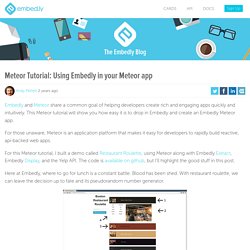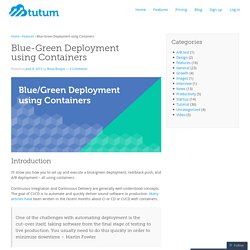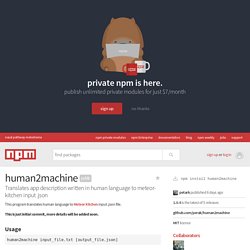

7 things you didn’t know about JavaScript — Just JavaScript. The WebAPI JavaScript isn’t the same buggy language it was 10 years ago.

React: The Hype is Real. I haven’t been so excited since the early days of jQuery.

React is a JavaScript library initially developed by Instagram/Facebook for building user interfaces. Since it has received a lot of attention recently with companies like Netflix, Walmart, Tesco, Airbnb and Flipboard moving significant amounts of their UI code over to it, it’s a good idea to see what all the fuss is about. There’s other opinions out there that discuss pros and cons of JavaScript frameworks. In this particular article it discusses the lack of longevity in frameworks and includes this cheeky image: What the author of the article doesn’t address is jQuery. jQuery isn’t “hot” right now but its usage dwarfs all of these frameworks. For me, React is like the Second Coming of jQuery. JS Framework History 101 The Rise of jQuery. Creating Isomorphic Apps with Node.js, React, and Express.
Over the past few years, the Web community has been abuzz with “isomorphic apps”.

They are apps where the markup is rendered on the server and fed to the browser as complete HTML, and the successive user interactions are handled by client side rendering. This is useful as it lead to outcomes like faster page loading, better search engine indexing, and better user experience. In this tutorial, we’ll crate a simple isomorphic app that uses Node, React, and Express to understand the underlying process behind it. The Tech Stack In this article, we’re going to use following software:
Embedly Blog : Meteor Tutorial: Using Embedly in your Meteor app. Meteor Tutorial: Using Embedly in your Meteor app Embedly and Meteor share a common goal of helping developers create rich and engaging apps quickly and intuitively.

This Meteor tutorial will show you how easy it is to drop in Embedly and create an Embedly Meteor app. For those unaware, Meteor is an application platform that makes it easy for developers to rapidly build reactive, api-backed web apps. For this Meteor tutorial, I built a demo called Restaurant Roulette, using Meteor along with Embedly Extract, Embedly Display, and the Yelp API. The code is available on github, but I’ll highlight the good stuff in this post. The Hitchhiker's Guide to Modern JavaScript Tooling - React Kung Fu. A lot of developers coming to JavaScript world attracted by React.js are confused with the tooling used to produce modern JavaScript code.

Webpack, Babel, ESLint, Mocha, Karma, Grunt… what should I use and which tool is doing what? JavaScript newcomers are often people coming from communities like Ruby and Java where opinionated, full-stack solutions exist. Frameworks like Ruby on Rails provide a lot of features out of the box - in fact the problem you may have with JavaScript is caused by that. Meteorflux:dispatcher package. What is Flux and why do I need it?

Most people using Meteor today come from creating "server side" or "page based" websites. The user asks for a url and the server returns the correct page. A Meteor.js Review and Tutorial for Single Page Web Application Development. Introduction Single page web applications are an important part of modern web development.

Users expect web applications to function much more closely to their desktop counterparts. This includes both PC and mobile-based devices. With the challenges of single page web application development, there have been a number of frameworks that have arisen to help rapidly create and deploy these types of projects. Blue-Green Deployment using Containers. Introduction I’ll show you how you to set up and execute a blue/green deployment, red/black push, and A/B deployment – all using containers.

Continuous Integration and Continuous Delivery are generally well-understood concepts. The goal of CI/CD is to automate and quickly deliver sound software to production. Many articles have been written in the recent months about CI or CD or CI/CD with containers. One of the challenges with automating deployment is the cut-over itself, taking software from the final stage of testing to live production. Automated builds : Tutum. Tutum can automatically build images from GitHub repositories.

To enable this, you must follow these steps: Link your GitHub accountCreate an empty repository in Tutum's registryEdit the repository to configure the source GitHub repository and the source branches for each repository tag to be built Once your repository is configured, a git push to a branch which has been set as a tag source will trigger a build. Builds are done inside containers which run on your nodes. Deploying with Docker on Tutum - deployment - Meteor forums. Ionic: Advanced HTML5 Hybrid Mobile App Framework. Human2machine. Translates app description written in human language to meteor-kitchen input .json This program translates human language to Meteor Kitchen input .json file.

This is just initial commit, more details will be added soon. Usage human2machine input_file.txt [output_file.json] Example input files. Meteor Kitchen. Deploying · Telescope. Meteor Toys. Things I Have Learned as a New Meteor Developer. Twitter Monitoring Apps with MeteorJS Building from Scratch. My recent years of interests and works were all about social media monitoring. We had built an enterprise grade version, Croakun based on python/django, tracking facebook, twitter, instagram, youtube, blogs, forums, … and presented in interactive dashboard for decision making.